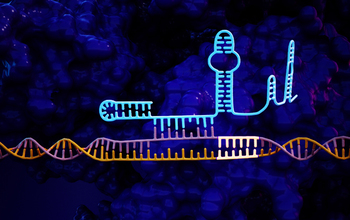Multimedia Gallery
CRISPR/Cas9 genetic sequence with a 'hairpin' lock
An artist’s representation of the CRISPR/Cas9 genetic sequence with a "hairpin" lock added to the left side of the system, a new approach created by biomedical engineers at Duke University that will improve the accuracy of the CRISPR genome editing technology by an average of 50-fold. The approach adds a short tail to the guide RNA, which is used to identify a sequence of DNA for editing. This added tail folds back and binds onto itself, creating a "lock" that can only be undone by the targeted DNA sequence.
[Research supported in part by National Science Foundation grants DMR 17-09527 and EFMA 18-30957.]
Learn more about this research in the Duke news story Engineering 'hairpins' increases CRISPR accuracy. (Date image taken: April 10, 2019; date originally posted to NSF Multimedia Gallery: Oct. 2, 2019)
Credit: Ella Maru
Images and other media in the National Science Foundation Multimedia Gallery are available for use in print and electronic material by NSF employees, members of the media, university staff, teachers and the general public. All media in the gallery are intended for personal, educational and nonprofit/non-commercial use only.
Images credited to the National Science Foundation, a federal agency, are in the public domain. The images were created by employees of the United States Government as part of their official duties or prepared by contractors as "works for hire" for NSF. You may freely use NSF-credited images and, at your discretion, credit NSF with a "Courtesy: National Science Foundation" notation.
Additional information about general usage can be found in Conditions.
Also Available:
Download the high-resolution JPG version of the image. (600.3 KB)
Use your mouse to right-click (Mac users may need to Ctrl-click) the link above and choose the option that will save the file or target to your computer.

